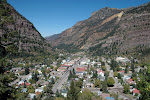The following was provided by Sara Coulter of the San Juan Corridors Coalition. Thanks Susan!
The Uncompahgre River including the Ridgway Reservoir offers some of the best fishing in the area, providing brown, rainbow, and cutthroat trout in good numbers and some very large sizes. Dan Kowalski, CDOW Aquatic Biologist, will provide information about these fisheries in the next Living with Wildlife presentation, Thursday, March 12, 7 p.m., Ridgway Community Center, Railroad Avenue, Ridgway.
Dan Kowalski is responsible for the management of native and sport fish in the Gunnison, North Fork, San Miguel, and Uncompahgre River drainages. His area includes the rivers, lakes, and streams from the Grand Mesa south to Telluride and from the Utah line to Crystal Reservoir. Before starting this job in April of 2003 he was a seasonal employee for the DOW in the Northeast Region and held numerous research jobs in Colorado and Pennsylvania. He received his Master's degree in Fishery Biology from Colorado State University in June of 2002. At CSU he studied whirling disease on a project funded by the DOW and the National Partnership on the Management of Wild and Native Cold Water Fisheries. He completed his Bachelor's degree at The Pennsylvania State University in Wildlife and Fisheries Sciences with a Forestry minor.
Sport fishing generates considerable income for the tri-county area. According to CDOW data from 2002, the expenditures for fishing in Montrose County were $4,930,000; in Ouray County, $1,140,000; and in San Miguel County, $2,480,000.
All the trout in Colorado are descendants of Pacific or Atlantic salmon, but only one, the cutthroat trout, arrived here by itself to become the only native trout in the State. According to the CDOW, "the cutthroat trout is thought to have migrated up the Columbia and Snake river basins to the Green and Yellowstone river basins over the past two million years. They arrived in Colorado within the past 20,000 years, crossing the Continental Divide during the most recent Ice Age!" The rugged terrain of their habitat has led to isolation and the development of subspecies, three of which evolved in Colorado: the Colorado River cutthroat trout in drainages west of the Continental Divide, the Greenback cutthroat trout in the South Platte and Arkansas River drainages, and the Rio Grande cutthroat trout in streams that drain into the San Luis Valley. All three of these species have either been petitioned to be listed or are currently listed under the Endangered Species Act because the introduction of non native trout, especially rainbow trout that hybridize with cutthroat trout, and brook and brown trout that tend to replace them in streams and rivers, has dramatically reduced their numbers. The CDOW is participating in a Cutthroat Trout Recovery and Conservation Team.
Non-native species of trout—rainbow, brook, lake, and brown—were introduced into Colorado between 1870 and 1890 by settlers who brought them in containers from their home areas. Rainbow trout are native to the Pacific Northwest and descended from Pacific salmon. They are now the most common trout in Colorado and a favorite catch of anglers. Brook trout and lake trout are native to the tributaries of eastern North America and descended from salmon in the western Atlantic. Brook trout tend to overpopulate and out compete other species. Lake trout are native to the upper Great Lakes and other northeastern lakes. Brown trout are native to Europe and descended from salmon in the eastern Atlantic. Brown trout are widely distributed and well established in Colorado in every lake and mountain stream between 6,000 and 10,000 feet in elevation.
A non-native species of special interest in the Ridgway area is the kokanee salmon, a land-locked Pacific sockeye salmon that attracts eagles to the bridge in Ridgway during their fall spawning run. The DOW Roaring Judy Hatchery is another location to observe these fish in the fall when they travel 25 miles from Blue Mesa Reservoir back to their birthplace.
In managing the fisheries in Colorado, CDOW conducts regular fish and stream surveys to "track fish population trends, evaluate the effectiveness of management actions such as stocking and regulations, and establish realistic management goals for a given lake or stream." High priority and brood waters, such as the Gunnison River, are surveyed annually while smaller, more remote lakes and streams are surveyed once every 5-10 years. CDOW has recently started publishing this data to provide the public with the most up-to-date information available.
Whirling disease has become a particular concern for the survival of young trout in Colorado, especially rainbow trout, brook trout, and all the species of cutthroat trout that seem to be susceptible. Whirling disease is spread by a parasite that has two hosts—adult fish and Tubifex worms. It attacks the cartilage of young fish causing deformities of the skull and spine. Most infected young fish die within 3-6 months. Currently, there is no cure, and the parasite can persist indefinitely in the wild. Anglers are asked to avoid spreading the disease by thoroughly rinsing mud and weeds from vehicles, boats, trailers, anchors, axles, waders, boots, fishing equipment, and anything that can hold spores of mud-dwelling worms. In addition, anglers are asked not to transport any fish or aquatic plants from one body of water to another and not to dispose of fish entrails into any body of water.
Doors for this presentation will open at 6:30. Refreshments will include homemade cookies, coffee provided by Mountain Market, and tea provided by Cups.
SJCC sponsors the Living with Wildlife presentations featuring wildlife topics of interest to the community on the second Thursday of each month throughout the year.
For further information and to offer suggestions for this series, please contact Sara Coulter (626-4496, scoulter@towson.edu) or Shirley Jentsch (240-1319, sjentsch@montrose.net).


No comments:
Post a Comment